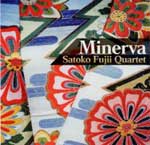Jazz In Japan
| |

| Much of the jazz I
get to hear comes from either the USA or UK, sometimes from Europe too, of
course. It's rare that I hear what's happening on the Japanese jazz scene,
an omission that these two new releases partially rectify. Satoko Fujii is
a pianist, composer, arranger, bandleader who has gathered around her some
fine musicians to produce a couple of stunning cds which show the versatility
of approach available to both quartet and big band. Achieving a balance between structured composition and freer improvisation in a big band setting must be a daunting task but one which can have spectacular results, especially for the audience. Chris McGregor's Brotherhood of Breath, Keith Tippett's Ark and Peter Brotzmann's Tentet are among those who have made enduring and exciting contributions to this area. Now this all- star Japanese line-up add their own rumbustious voices to the genre. The set was recorded live in 2002 and shows how Fujii and trumpeter Natsuki Tamura have written to create a dynamic between the fiery blowing and the more thematic ensemble playing of this 15 piece. At times it reaches the edges of exuberance and threatens to topple over into chaos but it never does, the structure of the writing and the experience of the musicians ensures this. ´Pakonya', the opening piece is a good example of what I mean. It starts freely then develops into a straight ahead vamp driven by Toshiki Nagata's bass. The horns state the theme together while Fujii throws in jagged fragments from around the keyboard. Out of this arise startling solos from Takao Watanabe's lucid trumpet and Ryuichi Yoshida's explosive baritone. The latter really digs in, wringing gruff shrieks and wild snarls from the big sax. It all comes back together again for the re-statement of the theme. Fujii's title track also displays the balance of ensemble work with duets between trumpet and trombone and some strident soloing , especially from Kenichi Matsumoto on tenor. He participates in one of the highlights of the track as he forms part of a trio with Nagata and Fujii, building up from delicate interplay to a fierce tumult that calls the whole band back in. Tamura's ´Wakerasuka' shows that there is room for humour in improvised music as the orchestra punctuate some eloquent soloing with raucous shouting culminating in a bizarre vocal solo from Kunihiro Izumi who chatters and bawls the piece to its conclusion. However weird the mix may sound it works by giving room to both the serious and the absurd. They achieve a balance. Possibly the most powerful display of the band's approach to freedom and restraint is on the three part suite, ´Joh-Ha-Cue'. The shimmering atmospherics of the opening make you hold your breath. They then develop a range of moods that foreground soloists like altoist Izumi, Watanabe again and the titanic tenorist Katayama. The orchestra shifts colours behind the solos and occasionally bass and piano accents provide further textures. It is a masterful demonstration of the orchestra's ability to harness their immense power and virtuosity in full flight and in individual spotlights. They have all the energy and intensity that can make improvised music edgy and exciting but they also have the rigorous structure of the big band to shape their overall sound. If they ever come within travelling distance see them. I know I will. The Fujii quartet make it quite clear where they are coming from and where they want to take you. From the opening of ´ Tatsu Take' they unleash a muscular fusion of free jazz empathy and edginess with rock-inspired energies. And they demonstrate that the two are entirely compatible. The hammering staccato rhythms of the opener give way to inspired solos by both trumpeter, Tamura and Fujii. The energy is relentless but they remain in control, shaping the improvisations and harnessing their collective power. The drumming of Tatsuya Yoshida plays a pivotal role integrating the unit and defining its essential tightness. He also produces wordless, processed vocals on the opening of ´Warp'. Well, it's interesting, but what he really brings to the track is a crisp, hard-edged groove which he sets up with Takeharu Hayakawa's bass. This underpins the whole piece and allows Fujii absolute freedom to explore the piano's range of sonorities. She makes full use of the opportunity and sends cascades of splintering runs flying in all directions. But again it is never just an opportunity to create a little sound and fury. She varies the attack, sometimes placing angular chords beneath the trumpet, sometimes raking the darkness from the corners of her keyboard. And all the time that drum and bass anchor and propel the explorations. They exhibit the high energy and unity of say, early King Crimson, alongside the explosive pianistics of Keith Tippett. Not a bad combination. In amongst the creative welter there are moments of calm, such as the start of ´Selvedge' where mournful trumpet exhales against the piano's filigree inventions. And ´Weft' begins with rhapsodic solo piano before a trumpet/piano duet unfolds the more reflective aspect of the quartet. It gradually evolves into a mid-tempo groove, balancing the force and restraint of drums, and showcasing searching solos from both trumpet and piano. The latter is particularly memorable in merging melody and rhythm. Theirs is an impassioned approach to free jazz allied with certain rock sensibilities. It works. Try it. © 2003 Paul Donnelly |